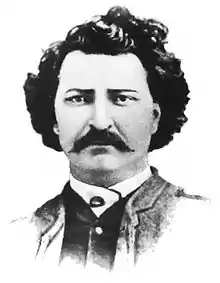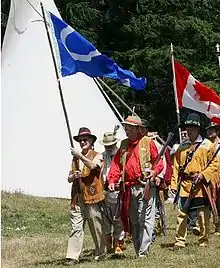List of Métis people
This is a partial list of Canadians who are of Métis descent.
| Indigenous peoples in Canada |
|---|
.JPG.webp) |
|
Prominent Métis
Historical

Louis Riel. c.1884
- Howard Adams, Métis activist, author, and leader
- Andre Beauchemin, Métis; First Member of the Legislative Assembly of Manitoba for St. Vital (French Party) 1870-1874. In November 1872, Beauchemin offered to resign his seat in the Manitoba assembly so that Riel could be elected in a by-election
- Pierre Bottineau, Minnesota frontiersman, surveyor, diplomat and translator
- Michel "Mitch" Bouyer, Métis of French Canadian and Sioux ancestry; interpreter and guide in the Old West; lead scout with the US Seventh Cavalry; died along with Lt.Col. George Armstrong Custer at the Battle of Little Bighorn on June 25, 1876
- James P. Brady, Métis politician and activist
- Pierre Delorme, Métis politician and activist. Elected as a Member of Parliament in 1871, defeated in 1874 and re-elected in 1878.[1]
- Gabriel Dumont, Métis military leader during the North-West Rebellion
- Cuthbert Grant, Métis political and military leader
- John Norquay, Métis politician, Premier of Manitoba from 1878 to 1887
- Malcolm Norris, Métis politician, activist, and leader. Norris was a founder and the first vice-president of the first Alberta Métis organization (1932) called the Association des Métis d’Alberta et des Territories du Nord-Ouest (Alberta Métis Association). In 1964, he headed the Métis Association of Northern Saskatchewan.
- Louis Riel, Métis leader who led the Red River Rebellion in 1869 - 1870, the provisional government of Rupert's Land, Manitoba's entry into Confederation in 1870; later led the North-West Rebellion in 1885[2] Riel was elected three times to the House of Commons for Provencher riding; first, in the general election of 1873, the government subsequently resigned over the Pacific Scandal in November 1873. Riel was reelected in February 1874, then expelled, then ran in the subsequent by-election, was reelected and expelled again.[3]
- Louis Schmidt, Métis politician, Riel's Secretary and, in their youth, Riel's classmate. Born in 1844 he was known as Louis Laferté until Bishop Taché changed it in 1858. Louis Schmidt made the first of numerous petitions on behalf of the Métis' to the federal government over rights to their lands and their call for proper political representation. See Louis Schmidt: A Forgotten Métis in Riel and the Métis Ed. A.S Lussier (1979) Manitoba Métis Federation Press.
Architects
- Douglas Cardinal, architect; of Métis and Blackfoot ancestry. He designed the Museum of Canadian History and did the building designs for the Oujé-Bougoumou community of the James Bay Cree. This work won the “We the People” United Nations Community Award.[4]
Artists and writers

George R. D. Goulet, 2007 (shown carrying the Métis flag) and leading the Grand Entry at the Red River West celebration
- Keith Barker, playwright
- Joe Fafard (artist) Métis artist from Saskatchewan whose work has been featured across Canada and around the world
- Sandra Birdsell, daughter of a Métis man and a Russian Mennonite woman; based her award-winning novel Children of the Day in part on her parents' experiences in Manitoba in the 1920s to 1950s
- Robert Boyer (1948–2004); Métis Cree artist, best known for his politically charged "Blanket Statements" series of paintings[5]
- Alec Butler[6]
- Maria Campbell, Métis writer and filmmaker; born in northern Saskatchewan in 1940; brought the struggles of modern-day Métis and Aboriginal people to the public through her breakthrough book, Halfbreed (1973), and the collaborative play, Jessica (1982); captured the sound and song of traditional stories through her work in dialect, Stories of the Road Allowance People (1996)[7]
- Cherie Dimaline, writer, was awarded the Anskohk Fiction Book of the Year Award in 2013.
- George R. D. Goulet, best-selling Métis author; books include The Trial of Louis Riel: Justice and Mercy Denied, The Metis: Memorable Events and Memorable Personalities, and The Métis in British Columbia: From Fur Trade Outposts to Colony
- Dylan Miner, Métis printmaker, writer and conceptual artist[8]
- Rick Rivet (born 1949), painter
- Gregory Scofield, acclaimed poet, beadwork artist, dramatist, non-fiction writer, activist and educator[9]
- Kamala Todd, community planner, filmmaker, curator
- Loretta Todd, filmmaker, producer, cultural theorist
- Katherena Vermette, writer
- Christine Welsh, documentary filmmaker and academic
Musicians
- Arlette Alcock, musician, songwriter, and social activist
- Celeigh Cardinal, singer-songwriter
- Jon Gallant, bassist for the Canadian band Billy Talent
- Jani Lauzon, musician
- Andrea Menard, actress, playwright, and singer; Métis
- Kinnie Starr, musician
- Laura Vinson, musician
Politicians, activists, lawyers, physicians and judges
- Rod Bruinooge, Métis; Member of Parliament for Winnipeg South (Conservative Party of Canada); Parliamentary Secretary to the Minister of Indian Affairs & Northern Development; Federal Interlocutor for Métis and Non-Status Indians from 2005 until the fall of 2008
- Thelma J Chalifoux, Métis; community activist; First Aboriginal Woman appointed to the Senate of Canada on November 26, 1997, established Michif Cultural and Resource Institute,[10]
- Todd Ducharme, Métis; appointed as a judge in 2004 of the Ontario Supreme Court of Justice.
- Shelly Glover, Métis; Member of Parliament for Saint-Boniface (Conservative Party of Canada) 2008-2015; Parliamentary Secretary for Official Languages
- Dan Vandal, Métis; Member of Parliament for Saint-Boniface and Saint-Vital (Liberal Party of Canada) 2015-current; Parliamentary Secretary for Indigenous Services
- Carole James, former British Columbia New Democratic Party leader; Métis
- Derrick O'Keefe, Rabble.ca editor; Canadian anti-war movement leader; Métis
- Brian Bowman, Métis; mayor of Winnipeg
Sports
- Arron Asham, professional ice hockey player

Sharon Bruneau, a Canadian champion bodybuilder
- René Bourque, NHL hockey player; from Lac La Biche, Alberta; a Métis
- Sharon Bruneau, bodybuilder and fitness model
- Shayne Corson, NHL Player; Métis ancestry
- Theoren Fleury, Canadian former professional ice hockey player
- Travis Hamonic, professional ice hockey player for the Calgary Flames
- Dwight King, professional ice hockey player for the Los Angeles Kings
- Vic Mercredi, Atlanta Flames first round draft pick
- Kevin O'Toole, 1996 North American light heavyweight bodybuilding champion
- Wade Redden, NHL defenceman; of Métis ancestry
- Sheldon Souray, NHL defenceman; of Métis ancestry
Others
- Tantoo Cardinal, actress; of Métis and Cree ancestry
- Roseanne Supernault, actress; Métis of Cree descent
- Zoe Todd, academic
Notes
- Barkwell, Lawrence. https://www.scribd.com/document/324121091/Metis-Members-of-the-Legislative-Assembly-of-Manitoba
- Reasonable doubts may be raised about whether either of these events was a rebellion. For example, the actions considered rebellious in 1869 were undertaken by Riel as the leader of a government recognized by Canada as in legitimate control of territory that did not belong to Canada; Canada negotiated the Manitoba Act with this government. After these "rebellions", land speculators and other non-Métis effectively deprived the Métis of land by exploiting a government program for its purchase, with the government perhaps turning a blind eye. The province of Alberta distributed land to Métis in 1938 to correct what it believed to be an inequity, but Saskatchewan and Manitoba have not followed Alberta's lead.
- http://www.biographi.ca/en/bio/riel_louis_1844_85_11E.html
- http://www.metismuseum.ca/media/document.php/11995.Douglas%20Cardinal.pdf
- Jacoby-Smith, Jennifer. "The Painterly Life of Bob Boyer." University of Saskatchewan: Green and White. Winter 2005 (retrieved 23 November 2009)
- Gloria Kim, "Why be just one sex?" Archived 2010-06-13 at the Wayback Machine.
- Maclean's, September 8, 2005.
- "Membership." Archived 2006-04-20 at the Wayback Machine Aboriginal Curatorial Collective. (retrieved 13 February 2010)
- Barkwell, Lawrence. http://www.metismuseum.ca/media/document.php/13481.Gregory%20Scofield.pdf
- https://www.theglobeandmail.com/news/politics/thelma-chalifoux-was-the-first-metis-woman-to-serve-in-canadas-senate/article36520657/
This article is issued from Wikipedia. The text is licensed under Creative Commons - Attribution - Sharealike. Additional terms may apply for the media files.